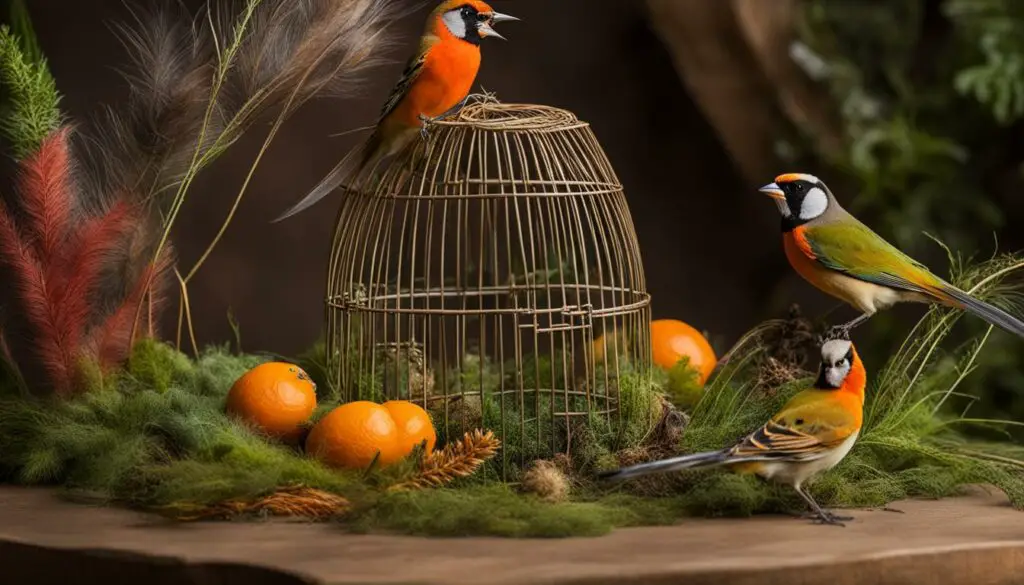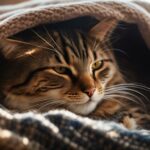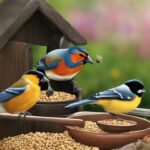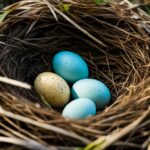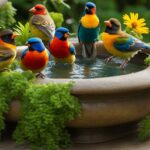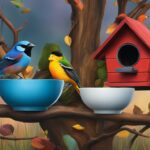Giving your feathered friends a safe and comfortable environment to build their nests is essential for promoting their well-being. When it comes to finches, providing the right nesting materials is crucial to ensure the health of the birds and their chicks. By offering natural and organic options, you can mimic their natural habitats and support their nesting instincts. Let’s explore some of the best finch nesting material suggestions to create a haven for these beautiful creatures.
Key Takeaways:
- Choose natural and organic materials to promote healthier nest-building habits for finches.
- Avoid synthetic materials or those treated with chemicals to prevent potential dangers to birds and their chicks.
- Understanding finch nesting behavior and preferences helps attract them to your yard.
- Provide safe options like twigs, leaves, grass clippings, and native plants to create a comfortable and secure environment for nesting.
- Avoid using materials like human hair, yarn or string, dryer lint, plastics, and chemicals that can pose hazards to birds.
Importance of Providing Safe Nesting Materials
As a bird enthusiast, I have always been fascinated by finches and their nesting behaviors. These small, colorful birds have a strong instinct to build nests, and providing them with safe materials is crucial for their well-being. By understanding finch nesting behavior and preferences, we can create an environment that attracts these beautiful birds and supports their breeding habits.
Finches have a natural inclination to collect materials like twigs, leaves, and grass to construct their nests. These materials not only provide structural support but also play a vital role in insulation and camouflage. By offering suitable nesting materials, we can ensure that finches can build secure and comfortable nests, protecting their eggs and hatchlings from the elements and potential predators.
“Understanding finch nesting preferences and providing safe options can attract these birds to your yard and ensure the health and well-being of the birds and their offspring.”
It is important to note that not all materials are safe for finch nests. Synthetic materials or those treated with chemicals can pose risks to the birds and their chicks. Natural and organic materials are recommended to avoid these potential dangers. By opting for materials found in their natural habitats, such as twigs, leaves, grass clippings, and native plants, we can provide a secure and bird-friendly environment for nesting.
By proactively providing suitable nesting materials for finches, we not only attract these birds to our yards but also contribute to the overall health and conservation of bird populations. Understanding their nesting behaviors and meeting their preferences ensures that finches have a safe and comfortable space to raise their young, ultimately supporting their vital role in our ecosystems.
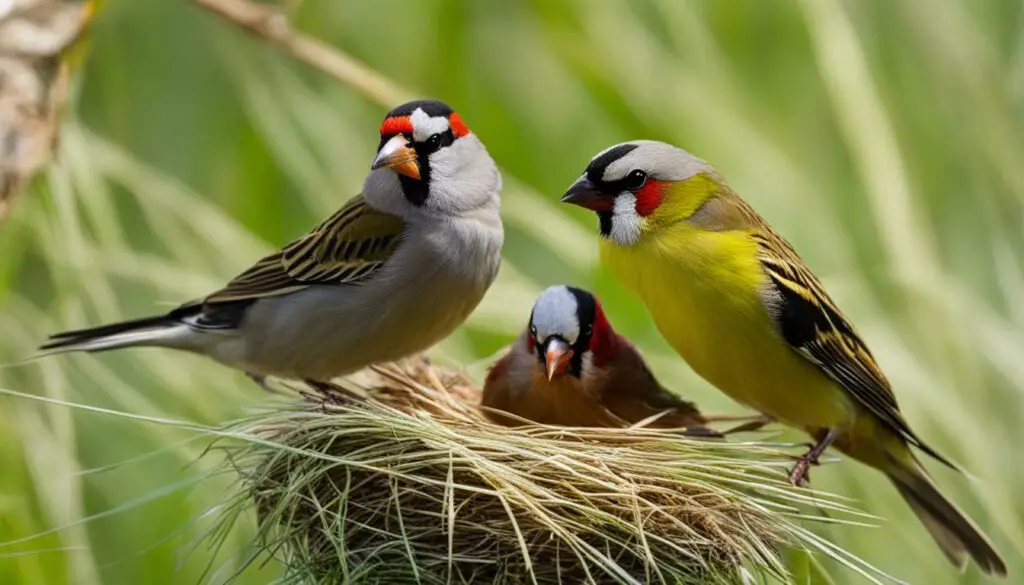
Suitable Natural Nesting Materials for Finch Nests
When it comes to creating a safe and comfortable nesting environment for finches, choosing the right materials is crucial. Natural nesting materials not only mimic their natural habitats but also provide a secure space for them to lay eggs and raise their chicks. Here are some suitable options for finch nests:
Table: Natural Nesting Materials for Finch Nests
| Material | Benefits |
|---|---|
| Twigs or Small Sticks | Provide structure and stability to the nest |
| Leaves and Yard Waste | Offer insulation and camouflage for the nest |
| Small Pieces of Straw | Create a soft and comfortable nesting bed |
| Grass Clippings | Provide additional insulation and nesting material |
| Native Plants | Offer natural nesting materials and attract insects for food |
These natural materials are easily accessible and can be sourced from your surroundings or purchased from local gardening stores. It’s important to ensure that the materials you gather or buy are free from harmful chemicals or pesticides that could harm the birds.
By providing the right nesting materials, you can create an inviting environment for finches to build their nests and increase the chances of successful breeding. Remember to place the nesting materials in a secure and protected area to prevent disturbances or predation.
Materials to Avoid for Finch Nests
When providing nesting material for finches, it’s essential to steer clear of certain materials that can pose hazards to these delicate birds. To ensure the safety and well-being of the finches and their nestlings, avoid using the following materials:
- Human hair: While human hair may seem like a soft and cozy option, it can easily ensnare birds and restrict their movements. It is best to keep human hair away from finch nesting areas.
- Yarn or string: These materials can be entangled around hatchlings’ legs or wings, potentially leading to injuries or even fatalities. It’s crucial to remove any yarn or string from the vicinity of finch nests.
- Dryer lint: Although dryer lint may appear fluffy and suitable for nesting, it loses its structure when wet, which can cause the nest to collapse. Avoid offering dryer lint as a nesting material to finches.
- Plastics and chemicals: Plastics can break down into small pieces, posing a choking hazard to finches and their young. Additionally, chemicals found in certain materials can be toxic to birds. It’s important to avoid using any plastics or chemically treated materials in finch nesting areas.
By steering clear of these materials, you can create a safer environment for finches to build their nests and raise their young. Opting for natural and organic options will help promote the health and well-being of these beautiful birds.
Finch Nesting Material Recommendations from Experts
When it comes to providing nesting materials for finches, experts recommend using organic and natural options. These materials not only simulate the birds’ natural habitats but also promote their health and well-being. By offering a variety of bird-friendly nesting materials, you can attract finches to your yard and support their nesting needs.
Some of the recommended materials for finch nests include twigs or small sticks, leaves, straw, grass clippings, and native plants. These natural materials provide a comfortable and secure environment for nesting, ensuring the safety of the birds and their offspring. By incorporating these materials into your yard, you can create an ideal nesting space for finches.
Experts also advise avoiding certain materials that can be hazardous to finches. Plastics, yarn or string, dryer lint, and human or pet hair should be excluded from bird nesting areas as they can pose risks to the birds and their nests. By being mindful of the materials you provide, you can help create a safe and nurturing environment for finches.
Overall, following expert recommendations and providing bird-friendly nesting materials is crucial for attracting and supporting nesting finches. By offering organic and natural options while avoiding potential hazards, you can enhance the well-being of finches and contribute to the overall health of bird populations.
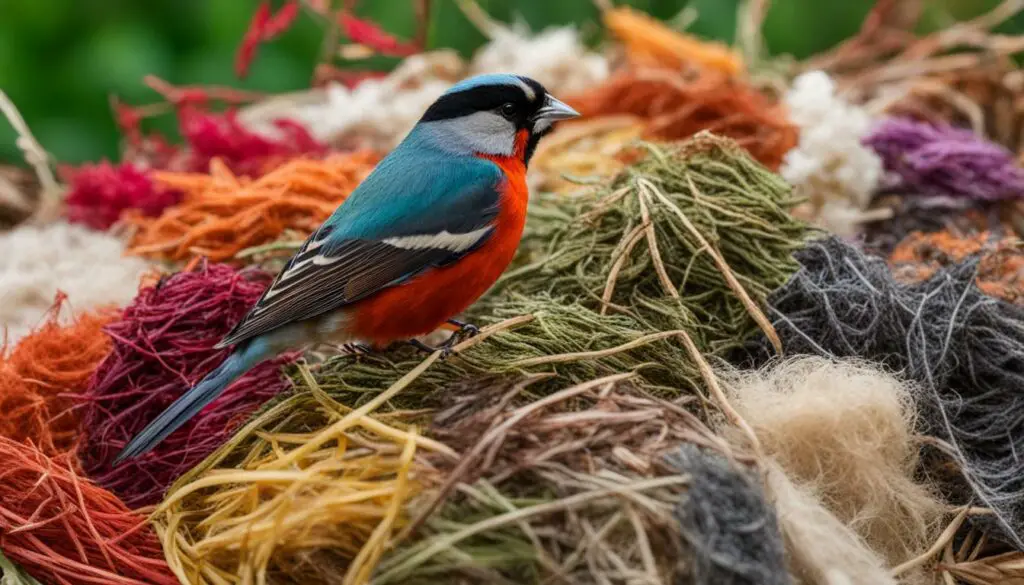
Expert Recommendations:
- Use natural materials such as twigs, leaves, and grass clippings.
- Avoid plastics, yarn or string, dryer lint, and human or pet hair.
- Provide a variety of nesting materials to attract different finch species.
- Incorporate native plants into your yard to create a bird-friendly environment.
| Nesting Material | Benefits |
|---|---|
| Twigs or small sticks | Provide a strong foundation for nests. |
| Leaves | Offer insulation and camouflage for nests. |
| Straw | Create a soft and cozy nesting environment. |
| Grass clippings | Provide additional cushioning and nesting material. |
| Native plants | Attract insects and offer natural nesting materials. |
Finch Nesting Material Products
When it comes to providing nesting materials for finches, there are several commercially available options that can make the process easier and more convenient. These products are specifically designed to cater to the nesting needs of finches and offer a range of materials to choose from.
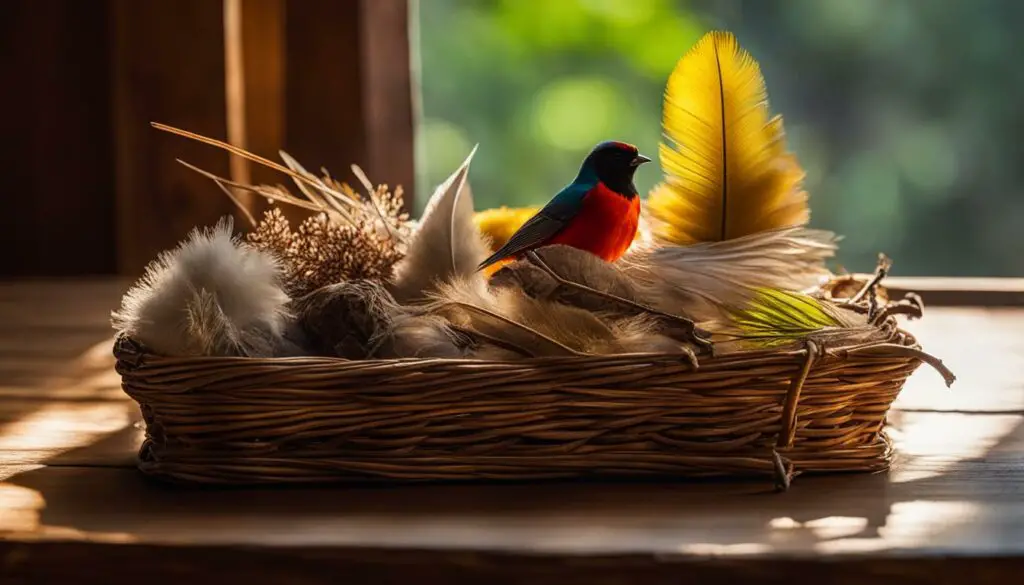
Some popular finch nesting material products include Coastal Hay, Cocofiber Nesting Fiber, Jute Nesting Fiber, Premium Nesting Fiber, Premium Super Nesting Fiber, and Sisal Nesting Fiber. Each of these options provides unique benefits and can be used based on the preferences of your finches.
| Nesting Material | Preferred by |
|---|---|
| Coastal Hay | Gouldian Finches |
| Cocofiber Nesting Fiber | African and Australian finches |
| Jute Nesting Fiber | Canaries and finches |
| Premium Nesting Fiber | Multiple finch species |
| Premium Super Nesting Fiber | Multiple finch species |
| Sisal Nesting Fiber | Australian finches |
Choosing the right nesting material for your finches can depend on factors such as their species and nesting preferences. By providing a variety of materials, you can allow your finches to select the ones that suit their needs best. Whether you opt for ready-made products or DIY alternatives, ensuring that the materials are safe and suitable for your finches is essential.
Coastal Hay: The Preferred Nesting Material for Gouldian Finches
Gouldian Finches are known for their vibrant plumage and playful nature. To ensure their health and well-being, it is crucial to provide them with suitable nesting materials. Among the various options available, Coastal Hay stands out as the preferred choice for Gouldian Finches.
Coastal Hay is a clean and disease-free natural material that closely resembles the type of nesting materials Gouldian Finches would find in their native habitats. Its soft texture and durability make it an ideal choice for creating a safe and comfortable nest.
When using Coastal Hay as a nesting material, it is important to ensure that it is properly cleaned and free from any harmful substances. This will help prevent potential health issues for the birds and their offspring. By offering Coastal Hay as a nesting material, you are not only providing a suitable option for nesting, but also promoting the natural nesting behavior of Gouldian Finches, which contributes to their overall well-being.
| Advantages of Coastal Hay as Nesting Material for Gouldian Finches | Disadvantages of Synthetic Materials for Finch Nests |
|---|---|
|
|
“Coastal Hay provides Gouldian Finches with a safe and comfortable nesting material that closely mimics their natural habitat. By using this preferred option, finch owners can ensure the well-being of their birds and support their natural nesting instincts.” – Finch Enthusiast Magazine
In summary, Coastal Hay is the top choice when it comes to nesting materials for Gouldian Finches. Its clean and natural composition, along with its resemblance to materials found in their native habitats, make it the preferred option for finch owners who prioritize the well-being and health of their birds.
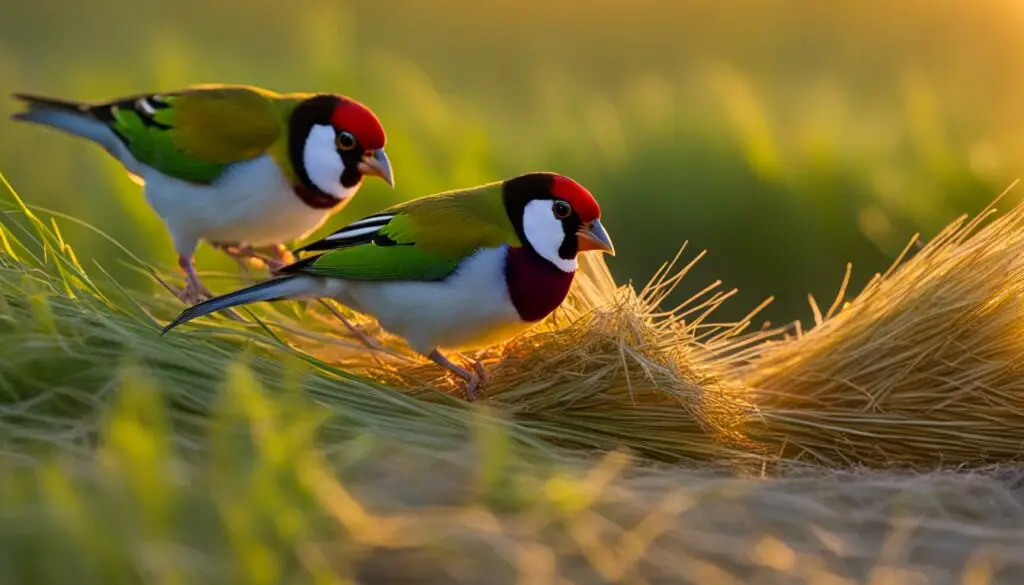
Cocofiber Nesting Fiber
The Cocofiber Nesting Fiber is a highly popular and sought-after nesting material for African and Australian finches. Its long, stiff fibers are loved by finch species that build their own free-standing nesting cavities. This unique material provides a suitable and natural option for finch nests, promoting a safe and comfortable environment for breeding and raising offspring.
Finches that prefer the Cocofiber Nesting Fiber include African species like the Gouldian Finch and certain Australian finches. The fibers in this nesting material are durable and sturdy, allowing the birds to construct secure and stable nests. The Cocofiber also provides insulation, protecting the eggs and hatchlings from temperature fluctuations.
By incorporating the Cocofiber Nesting Fiber into your finch habitat, you can enhance the nesting experience for your birds and increase their chances of successful breeding. The natural properties of this material mimic the finches’ natural surroundings, creating a sense of familiarity and comfort. Additionally, the Cocofiber is a substance that finches readily recognize and use as part of their instinctual nest-building behaviors.
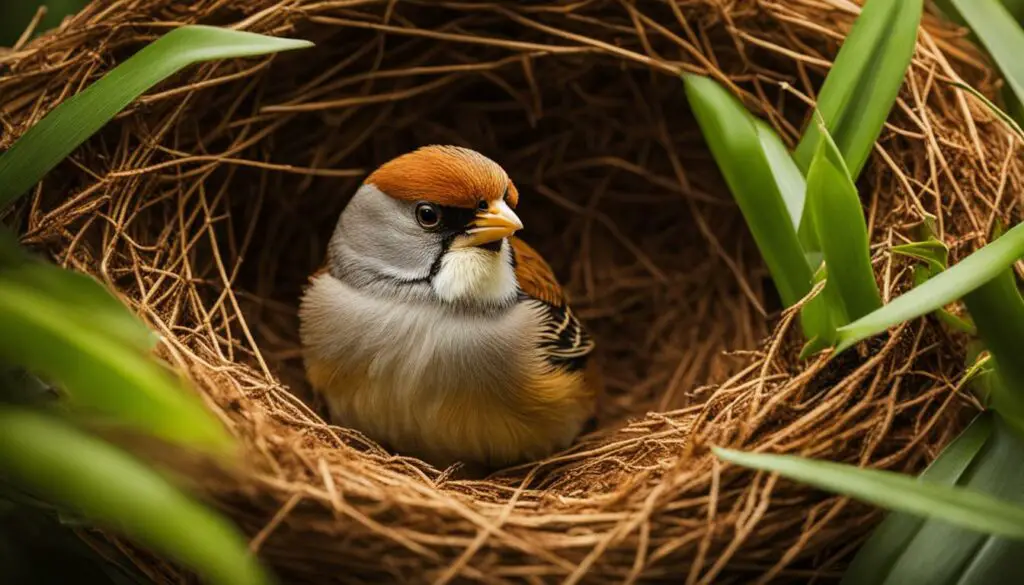
Advantages of Cocofiber Nesting Fiber:
- Provides a safe and natural nesting material for African and Australian finches
- Long, stiff fibers offer stability and durability for nest construction
- Insulation properties protect eggs and hatchlings from temperature fluctuations
- Mimics natural surroundings, promoting a sense of familiarity and comfort
- Recognized and used by finches as part of their instinctual nest-building behaviors
| Finch Species | Preferred Nesting Material |
|---|---|
| African Finches | Cocofiber Nesting Fiber |
| Australian Finches | Cocofiber Nesting Fiber |
Jute Nesting Fiber: The Perfect Nesting Material for Canaries and Finches
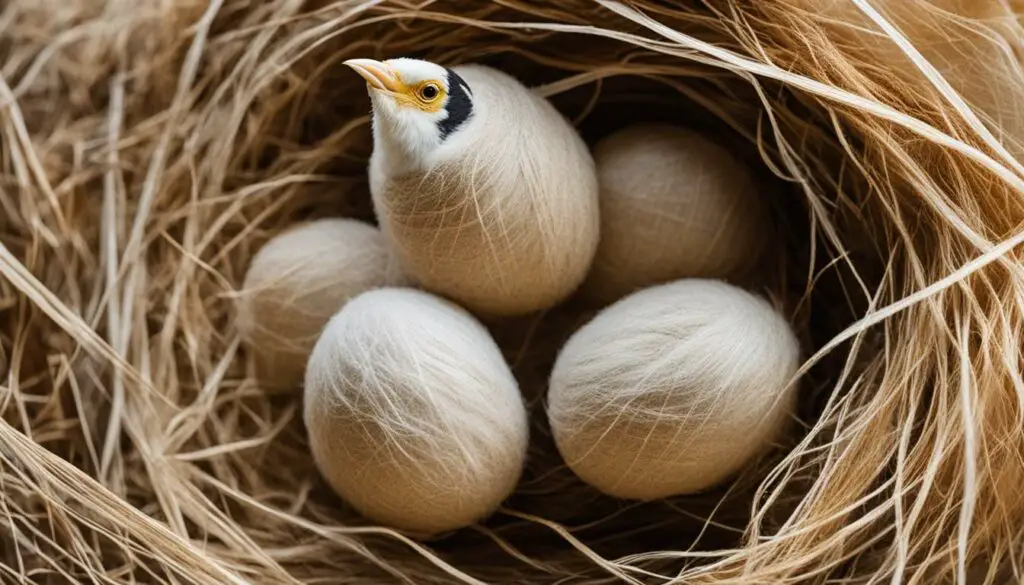
When it comes to providing nest-building materials for canaries and finches, Jute Nesting Fiber is a top choice. This short fiber material offers several benefits that make it the perfect option for these small avian species. From its soft and comfortable texture to its natural and safe composition, Jute Nesting Fiber meets the specific needs of canaries and finches.
Unlike longer and coarser fibers, Jute Nesting Fiber provides a cozy environment for birds to lay their eggs and care for their young. Its softness ensures that the delicate eggs and hatchlings are protected from any rough surfaces. Additionally, Jute Nesting Fiber is made from organic and natural materials, making it a safe option for canaries and finches.
The Advantages of Jute Nesting Fiber
There are several advantages to using Jute Nesting Fiber as a nest-building material for canaries and finches. Firstly, it offers excellent insulation properties, keeping the nest warm and cozy during cool temperatures. This is especially important for canaries and finches that live in colder climates or indoor aviaries.
Secondly, Jute Nesting Fiber is highly absorbent, helping to maintain the nest’s cleanliness by wicking away excess moisture. This can help prevent the growth of bacteria and fungi, creating a healthier environment for both the parent birds and their chicks.
Lastly, Jute Nesting Fiber is easy to work with, allowing the birds to shape and mold it to their liking. Its pliability makes it ideal for nest-building, as the birds can create a snug and secure structure.
The Perfect Choice for Canaries and Finches
When it comes to providing the best nesting material for canaries and finches, Jute Nesting Fiber is the perfect choice. Its softness, safety, insulation properties, absorption capabilities, and pliability make it an ideal option for these small avian species. By offering Jute Nesting Fiber in your bird’s habitat, you can ensure they have a comfortable and secure nesting space, promoting their overall well-being.
| Advantages of Jute Nesting Fiber |
|---|
| Soft and comfortable texture |
| Natural and safe composition |
| Excellent insulation properties |
| Highly absorbent, ensuring nest cleanliness |
| Easy to shape and mold for secure nests |
Premium Nesting Fiber: Multiple Nesting Material Choices for Finches
When it comes to providing nesting materials for finches, having multiple options is crucial to accommodate their individual preferences. That’s where Premium Nesting Fiber comes in. With its variety of materials, this nesting fiber offers a range of choices that ensure your finches can create a comfortable and secure environment for building their nests.
One of the options available in the Premium Nesting Fiber is Sisal, which is particularly favored by Australian finches. Its short white fibers provide a suitable and safe option for finch nests, allowing them to create cozy spaces for their eggs and hatchlings. Additionally, Jute is another material included in the Premium Nesting Fiber selection. Many finch species, including canaries, love this soft and comfortable fiber for their nests.
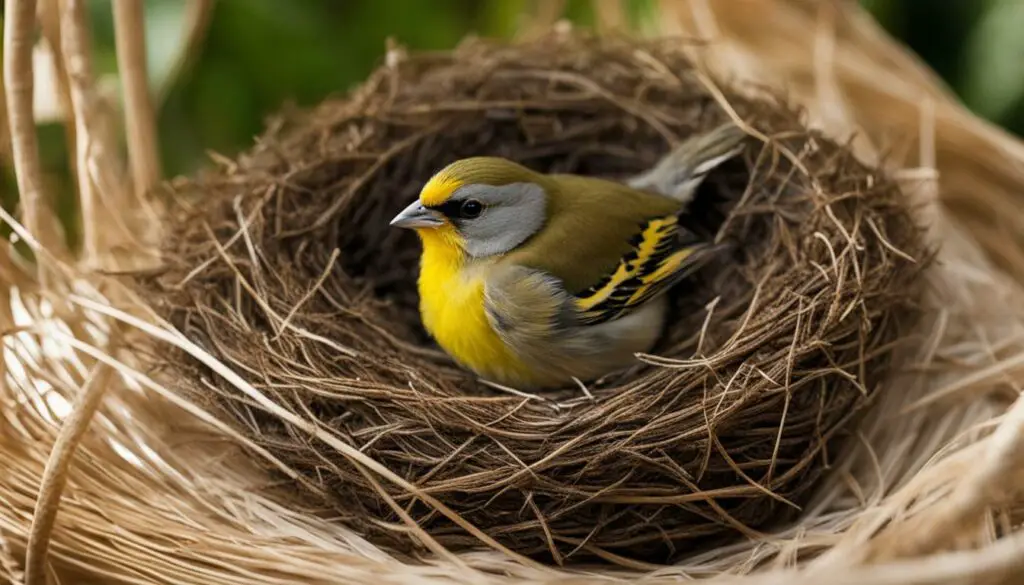
Another noteworthy component of the Premium Nesting Fiber collection is Cotton Pods. These natural pods provide a unique texture and nesting material option for your finches. Whether they choose to use the soft cotton or the pod itself as a building material, the variety offered by Cotton Pods appeals to the nesting instincts of different finch species.
Table: Comparison of Nesting Materials in Premium Nesting Fiber
| Nesting Material | Preferred Finch Species |
|---|---|
| Sisal | Australian finches |
| Jute | Canaries and many finch species |
| Cotton Pods | All finch species |
With the Premium Nesting Fiber, you can offer your finches a variety of nesting materials that cater to their specific needs and preferences. By providing them with a diverse range of options, you allow them to exercise their natural instincts and create nests that promote successful breeding and hatching. Invest in the Premium Nesting Fiber to ensure your finches have access to the best materials for their nesting endeavors.
Premium Super Nesting Fiber: Multiple Nesting Material Choices for Finches
When it comes to providing nesting materials for finches, the options are endless. One product that stands out is the Premium Super Nesting Fiber. This versatile nesting material offers a wide range of choices for finches, ensuring that you can meet their individual preferences and needs.
With Premium Super Nesting Fiber, you can create a diverse and stimulating environment for your finches. This product includes a combination of materials such as Sisal, Jute, Cotton Pods, Cocofiber, Moss, and even Horse Hair. Each material offers unique textures and qualities that can appeal to different finch species.
By offering a variety of nesting materials, you give your finches the opportunity to build their nests with the materials they prefer. Some finches may be drawn to the softness of the Jute Nesting Fiber, while others may prefer the sturdiness of Sisal. With Premium Super Nesting Fiber, you can cater to these preferences and provide an enriching nesting experience for your birds.
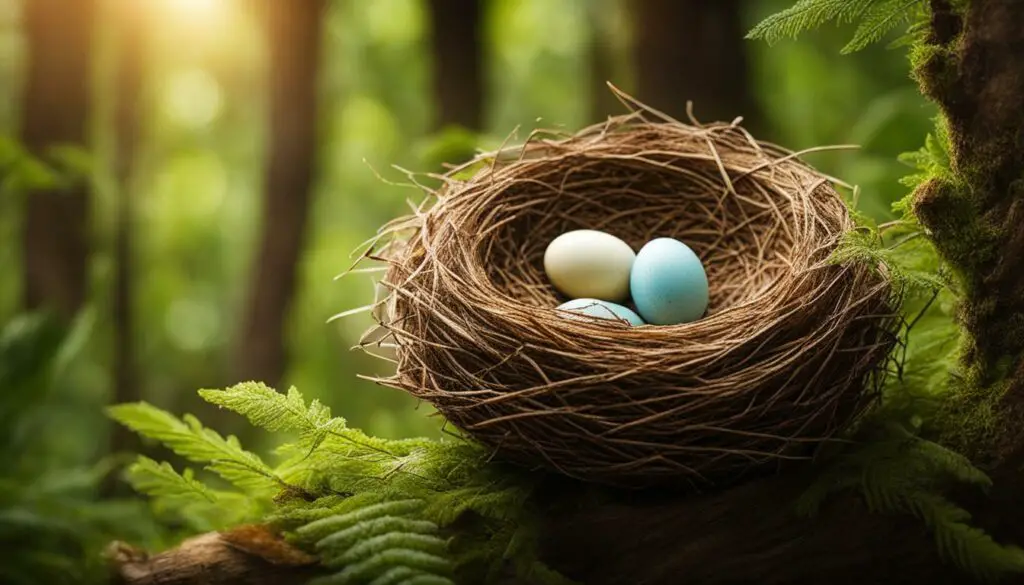
Table: Comparison of Nesting Materials in Premium Super Nesting Fiber
| Material | Texture | Preferred by |
|---|---|---|
| Sisal | Short white fibers | Australian finches |
| Jute | Short fibers | Canaries and many finch species |
| Cotton Pods | Fiber pods | Various finch species |
| Cocofiber | Long, stiff fibers | African and some Australian finch species |
| Moss | Soft, fluffy texture | Various finch species |
| Horse Hair | Long strands | Various finch species |
As you can see from the table, each material in the Premium Super Nesting Fiber offers distinct characteristics. This allows you to create an enticing and varied nesting environment for your finches. Whether they prefer the natural feeling of Sisal or the cozy texture of Moss, you can ensure that your finches have a range of options to choose from.
By providing multiple nesting material choices with Premium Super Nesting Fiber, you not only encourage your finches to build comfortable nests, but you also contribute to their overall well-being. The availability of diverse materials mimics the natural environment and empowers your finches to express their nesting instincts fully. So give your feathered friends the freedom to create their ideal nests with Premium Super Nesting Fiber.
Sisal Nesting Fiber: The Preferred Nesting Material for Australian Finches
When it comes to providing nesting materials for Australian finches, Sisal Nesting Fiber stands out as the preferred choice. Derived from the fibers of the agave sisalana plant, this natural material offers several benefits that make it ideal for finch nests.
Sisal Nesting Fiber provides a soft and comfortable bedding material for finches, creating a cozy environment for their eggs and hatchlings. The short white fibers are gentle on delicate feathers and ensure a snug nesting space. Additionally, the natural texture of sisal mimics the materials finches would encounter in their native habitats, promoting a sense of familiarity and security.
Another advantage of Sisal Nesting Fiber is its durability. The strong and resilient fibers hold their shape well, ensuring that the nest remains intact throughout the breeding season. This helps protect the eggs and nestlings from potential injuries caused by collapsing nests. The durability of sisal also makes it an eco-friendly choice, as it can be reused for future nesting seasons.
Sisal Nesting Fiber provides a safe, comfortable, and durable option for Australian finches to build their nests. Its natural texture and resilience make it an excellent choice for promoting successful breeding and the well-being of finches and their offspring.
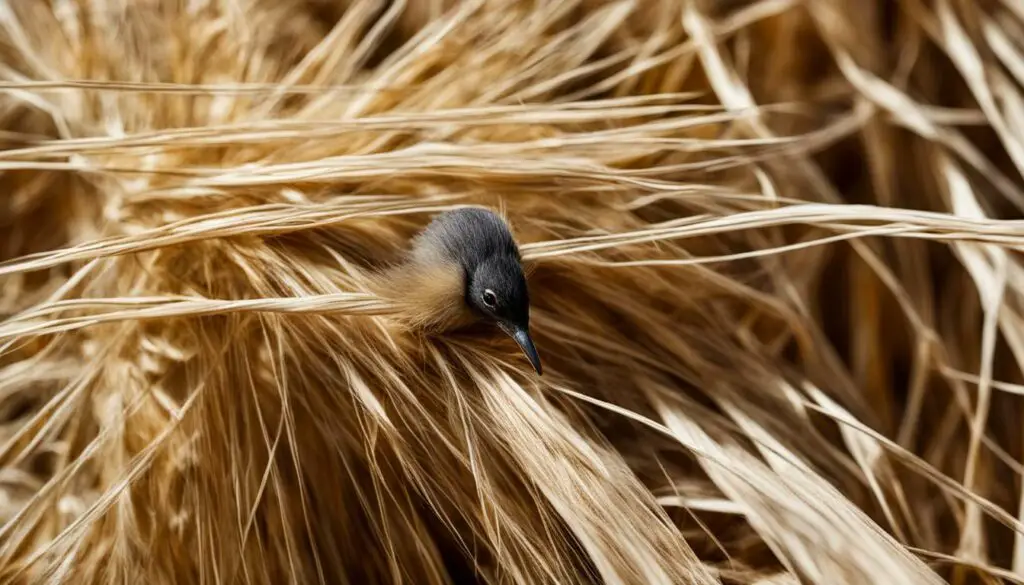
Comparing Nesting Materials for Australian Finches
| Nesting Material | Advantages |
|---|---|
| Sisal Nesting Fiber | Soft and comfortable, mimics natural materials, durable |
| Coastal Hay | Preferred by Gouldian Finches, clean, disease-free |
| Cocofiber Nesting Fiber | Loved by African and some Australian finch species, suitable for free-standing nesting cavities |
Table: A comparison of nesting materials for Australian finches.
While Coastal Hay and Cocofiber Nesting Fiber are also popular choices for Australian finches, Sisal Nesting Fiber offers a unique combination of comfort, natural texture, and durability. It provides a safe and secure nesting material that meets the specific needs of finches, ensuring the successful rearing of their young.
By incorporating Sisal Nesting Fiber into your finch breeding setup, you can create an inviting environment that supports the natural nesting instincts of these captivating birds. With the right materials, you’ll help ensure the health and well-being of Australian finches as they embark on their journey of reproduction.
Importance of Natural Nesting Materials from Nature
When it comes to creating a safe and comfortable environment for nesting birds, providing natural materials is crucial. Birds have evolved to build their nests using materials readily available in their natural habitats. By offering these materials in your yard, you can attract birds and support their nesting needs.
Safe bird nesting materials from nature include a variety of options. Twigs and small sticks provide a sturdy foundation for nests, while leaves and yard waste create a cozy inner lining. Dried grass clippings, moss, and plant fluff offer additional insulation. Straw and pine needles are also popular choices, providing structural integrity and protection from the elements.
By growing plants that offer shelter and leaving natural debris around your yard, you can provide an abundant source of nesting materials for birds. These materials not only mimic what birds would find in their natural habitats but also help create a diverse and bird-friendly ecosystem. So, let nature guide you when it comes to choosing safe and suitable nesting materials for our feathered friends.
Unsafe Bird Nesting Materials to Avoid
When providing nesting materials for birds, it is crucial to prioritize their safety and well-being. Certain materials can pose hazards to birds and should be avoided in their nests. Here are some examples of unsafe bird nesting materials to steer clear of:
Plastics
Avoid using plastics in bird nests as they can be harmful to birds and their chicks. Plastics do not break down easily and can cause entanglement or choking hazards. Opt for natural and biodegradable materials instead.
Yarn or String
While yarn or string may seem like suitable nesting materials, they can become entangled around birds’ legs, wings, or beaks, leading to injury or death. To ensure the safety of nesting birds, refrain from using yarn or string in their nests.
Dryer Lint
Dryer lint may seem like a convenient option for nesting material, but it loses its structure when wet. Wet lint can become compacted and create an unfavorable environment for the birds. Avoid including dryer lint in bird nests to provide a safer nesting environment.
Human Hair and Pet Hair
While human and pet hair can be soft and cozy, they can easily entangle birds and pose a risk to their safety. Avoid using human hair or pet hair as nesting materials to prevent potential harm to nesting birds and their offspring.
By being mindful of the nesting materials we provide, we can create a safer environment for birds to build their nests and raise their young. Opting for natural, biodegradable materials ensures the well-being of our feathered friends. Let’s prioritize their safety and contribute to healthier bird populations.
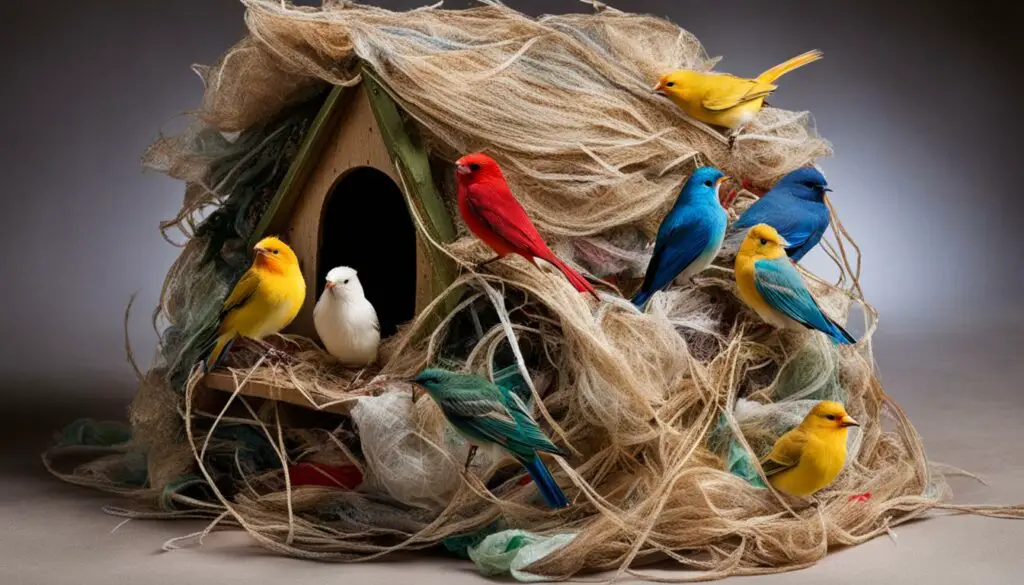
Attracting and Caring for Nesting Birds
To create a bird-safe backyard and attract nesting birds, there are several steps you can take. Providing suitable nesting materials is crucial, as it encourages birds to build their nests in your yard. Natural materials such as twigs, leaves, and grass clippings mimic what birds would find in their natural habitats and create a comfortable and secure environment for nesting.
Growing native plants is another effective way to attract nesting birds. Native plants provide food and shelter, making your yard an inviting habitat for birds. Research the native plants in your area and incorporate them into your garden to create a diverse and bird-friendly landscape.
In addition to providing nesting materials and native plants, maintaining a bird-safe environment is essential. Avoid using harmful chemicals and pesticides that can be toxic to birds. Keep your yard clean by removing potential hazards such as sharp objects, open containers of water, and exposed wires. By creating a safe and welcoming space, you can help support the breeding and nesting habits of a variety of bird species.
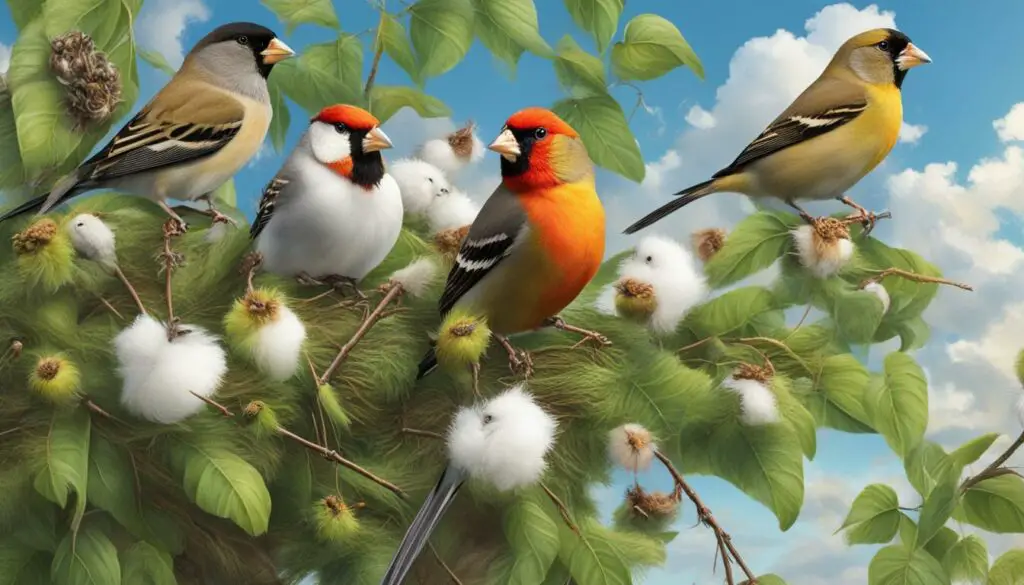
Key Tips for Attracting Nesting Birds:
- Provide suitable nesting materials such as twigs, leaves, and grass clippings.
- Grow native plants to provide food and shelter.
- Avoid using harmful chemicals and pesticides.
- Keep your yard clean and remove potential hazards.
By following these tips and creating a bird-safe backyard, you can enjoy the sights and sounds of nesting birds while providing them with a safe and nurturing environment.
Conclusion
In conclusion, providing suitable and safe nesting materials for finches is crucial for promoting healthier bird populations. By understanding their nesting behaviors and preferences, we can create an environment that attracts these beautiful birds and supports their nesting needs.
Natural and organic materials such as twigs, leaves, grass clippings, and straw mimic what birds would find in their natural habitats, offering a comfortable and secure environment for nesting. On the other hand, it’s important to avoid materials that can pose hazards, such as plastics, yarn or string, dryer lint, human hair, and pet hair.
Experts recommend using organic and natural materials for finch nests to ensure the well-being of the birds and their offspring. Additionally, commercially available nesting materials like Coastal Hay, Cocofiber Nesting Fiber, Jute Nesting Fiber, Premium Nesting Fiber, Premium Super Nesting Fiber, and Sisal Nesting Fiber provide convenient options for finch owners who prefer ready-made choices.
By creating a bird-friendly backyard with suitable nesting materials and native plants, we can attract and care for nesting birds, supporting their breeding and nesting habits. Together, we can enhance the well-being of finches and contribute to the preservation of healthy bird populations.
FAQ
What materials should I avoid when providing nesting materials for finches?
It is important to avoid materials such as plastics, yarn or string, dryer lint, human hair, and pet hair. These materials can pose hazards to birds and should be excluded from nesting areas.
What are some suitable natural nesting materials for finches?
Suitable natural nesting materials for finches include twigs or small sticks, leaves and yard waste, small pieces of straw, grass clippings, and native plants. These materials provide a comfortable and secure environment for nesting.
Are there commercially available nesting materials for finches?
Yes, there are several commercially available nesting materials specifically designed for finches. These include Coastal Hay, Cocofiber Nesting Fiber, Jute Nesting Fiber, Premium Nesting Fiber, Premium Super Nesting Fiber, and Sisal Nesting Fiber.
Which nesting material is preferred for Gouldian Finches?
The most preferred nesting material for Gouldian Finches is Coastal Hay. It is clean, disease-free, and provides a safe and natural option for finch nests.
What nesting material is loved by African and Australian finches that build their own free-standing nesting cavities?
Cocofiber Nesting Fiber, consisting of long, stiff fibers, is loved by finch species that build their own free-standing nesting cavities. It is particularly favored by African species and also used by some Australian finches.
What nesting material is loved by canaries and many finch species?
Jute Nesting Fiber, a short fiber material, is loved by canaries and many finch species. It provides a soft and comfortable option for nesting birds.
What options does Premium Nesting Fiber offer for finch nesting materials?
Premium Nesting Fiber offers multiple options, including Sisal, Jute, and Cotton Pods. This variety allows finch owners to choose the nesting material that best suits their birds’ preferences.
What options does Premium Super Nesting Fiber provide for finch nesting materials?
Premium Super Nesting Fiber provides a wide selection of nesting materials, including Sisal, Jute, Cotton Pods, Cocofiber, Moss, and Horse Hair. These options offer a range of textures and materials for finches to choose from.
What nesting material is used by most finch species, especially Australian finches?
Sisal Nesting Fiber, consisting of short white fibers, is used by most finch species, especially Australian finches. It provides a suitable and safe option for finch nests.
What natural materials can be used by birds to build their nests?
Birds can use natural materials like twigs, moss, dried grass clippings, dead leaves, plant fluff, straw, and pine needles to build their nests.
What should I avoid providing as nesting materials to birds?
It is important to avoid providing unsafe materials like plastics, yarn or string, dryer lint, human hair, and pet hair as nesting materials. These materials can pose hazards to birds and should be excluded from bird nesting areas.
How can I attract and care for nesting birds?
You can attract and care for nesting birds by providing suitable nesting materials, growing native plants, and maintaining a bird-safe backyard. Creating a welcoming environment with safe materials helps support the breeding and nesting habits of birds.
How can providing suitable and safe nesting materials enhance the well-being of finches?
By understanding finch nesting behavior and providing suitable and safe nesting materials, you can enhance the well-being of finches and promote healthier bird populations. Offering natural and organic options helps mimic their natural habitats and supports their nesting instincts.

